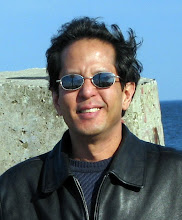 If you go to UCLA, you're well aware of the Hollywood legends of Francis Ford Coppola and Steven Spielberg. At USC, George Lucas has left his imprint by donating tons of money for entire buildings to be erected in his name. In the universe of film schools, UCLA, USC, and NYU are the creme de la creme. I'm not knocking other programs, like the American Film Institute (I was a Screenwriting Fellow there, too), SVA, Columbia, and scores of others. These 3 have the name recognition and their grads have made inroads in the cinema.
If you go to UCLA, you're well aware of the Hollywood legends of Francis Ford Coppola and Steven Spielberg. At USC, George Lucas has left his imprint by donating tons of money for entire buildings to be erected in his name. In the universe of film schools, UCLA, USC, and NYU are the creme de la creme. I'm not knocking other programs, like the American Film Institute (I was a Screenwriting Fellow there, too), SVA, Columbia, and scores of others. These 3 have the name recognition and their grads have made inroads in the cinema.
I didn't go to the California schools, so I can't attest to the lionizing of these aforementioned luminaries, but NYU in the 70's was a kind of shrine to Scorcese or, as everyone called him, Marty. Marty was our urban legend, a validator to the industry success possible to achieve by laying out significant mountains of gold to go to NYU Film.
Sight and Sound instructor (and future NYU Film Chair) Charlie Milne screened Marty's NYU short, "It's Not Just You, Murray" religiously each semester and we watched in silent awe at the master's work. If we behaved, we even saw the first feature Haig Manoogian produced with Marty as director, another Harvey Keitel indie must-see, "Who's That Knocking at my Door" - a precursor to Mean Streets in every stylistic sense. For the brief period of time I spent in his class, Mardik Martin was a humble, brilliant, soft spoken, and very real person, a consummate New Yorker and Hollywood outsider whom we could all easily identify with. The semi-autobiographical neo-realist homage to DeSica and Casavettes, Mean Streets, had just been released and Mardik announced to the class that he was moving out to Los Angeles to work with Scorcese on a new project.
For the brief period of time I spent in his class, Mardik Martin was a humble, brilliant, soft spoken, and very real person, a consummate New Yorker and Hollywood outsider whom we could all easily identify with. The semi-autobiographical neo-realist homage to DeSica and Casavettes, Mean Streets, had just been released and Mardik announced to the class that he was moving out to Los Angeles to work with Scorcese on a new project.
Mardik sat at the front of the room and intoned solemnly, "Look around you. These are the people you will be making movies with for the rest of your life. The friendships you make here will be intense, and the alliances you form will be your ticket someday."
We all gazed at the ragtag, semi-bohemian, blue-jeaned, mostly unkempt (the guys, I mean) assembly of misfits and artsy-craftsy long hairs and knew, deep down, Mardik was coming from a place of truth. We nodded slowly, taking in the gravity of his prophetic words. When class ended, we all bolted to the closest theater to catch Marty's and Mardik's breakthrough opus.
I can't tell you how exciting this seemed to me and how energized we felt as a class. I saw Mean Streets, and despite its rambling, almost flow-of-consciousness narrative structure, this was, without an iota of doubt, a love letter to New York, a slice of life from lower Manhattan, the culmination of Marty's sickly childhood staring out his window at the great panorama of Grand Street in the bosom of Little Italy. He captured the sights, sounds, smells, and people who populated this world so realistically, you could taste it.
 Harvey Keitel, and especially Robert DeNiro in his breakthrough role as the dim-witted Johnny Boy, gave luminescent performances so nuanced and naturalistic, they kicked you right in the cajones. Coppola's brilliant but definitely Hollywood Godfather was no comparison for the realism and grit of Marty's downtown world of hustlers and desperate wannabees. What this picture lacked in polish it made up for a hundred times over with heart and soul, the filmic blood of a tour-de-force talent to be reckoned with.
Harvey Keitel, and especially Robert DeNiro in his breakthrough role as the dim-witted Johnny Boy, gave luminescent performances so nuanced and naturalistic, they kicked you right in the cajones. Coppola's brilliant but definitely Hollywood Godfather was no comparison for the realism and grit of Marty's downtown world of hustlers and desperate wannabees. What this picture lacked in polish it made up for a hundred times over with heart and soul, the filmic blood of a tour-de-force talent to be reckoned with.
So two of NYU's proteges had made it big time, and the era of amazing pictures they would work on would absolutely blow me away: Raging Bull, Taxi Driver, Goodfellas, The Color of Money, my God, the list is endless.
I proclaim: one Scorcese picture has more talent, passion, and luminosity than a dozen crass Hollywood assembly line confections.
I rest my case (for now).







No comments:
Post a Comment